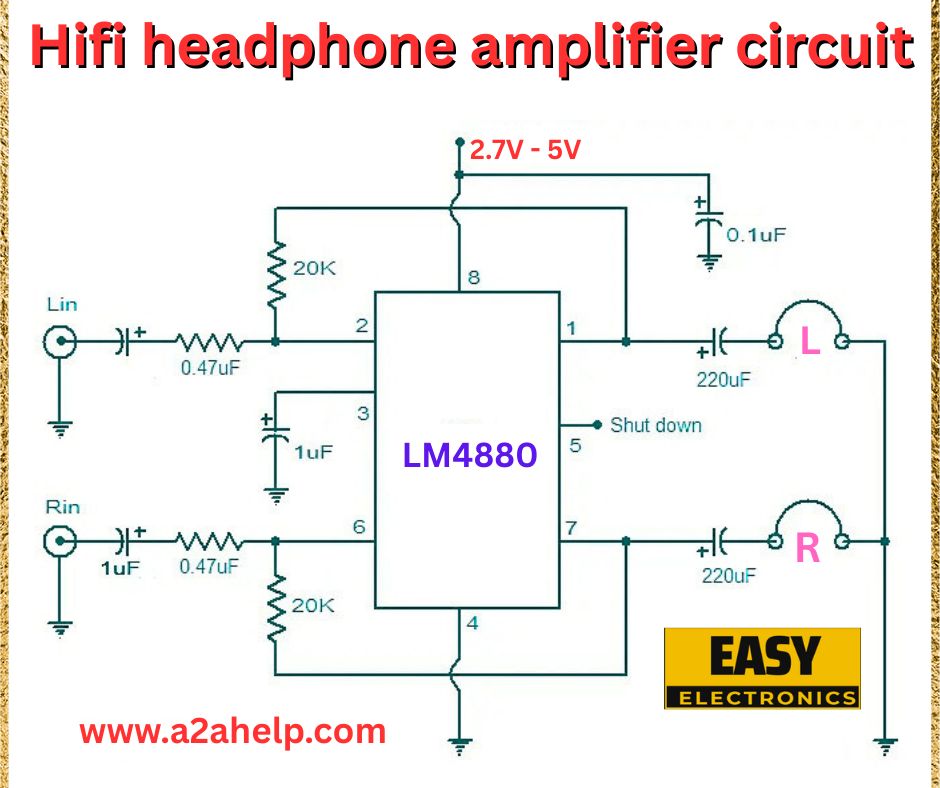Introduction to Hi-Fi Headphone Amplifiers
For audiophiles and music lovers, a high-fidelity (Hi-Fi) headphone amplifier can transform your listening experience by delivering clear, powerful sound. In this article, we’ll analyze the schematic, explain its components, and guide you through building your own amplifier to enjoy superior audio quality at home.
What is a Hi-Fi Headphone Amplifier?
A Hi-Fi headphone amplifier boosts the audio signal from your device (like a phone or MP3 player) to drive headphones effectively, especially high-impedance models. The LM4880, a low-power audio amplifier IC, is the heart of this circuit, offering excellent sound reproduction with minimal distortion. This design operates on a 2.7V to 5V power supply, making it versatile for portable or desktop use.
Analyzing the Hi-Fi Headphone Amplifier Schematic
Key Components
- LM4880 IC: A stereo audio power amplifier with shutdown functionality.
- 2.7V – 5V Power Supply: Provides the operating voltage for the circuit.
- 20kΩ Resistors: Set the gain and input impedance for the left (Lin) and right (Rin) channels.
- 0.47µF Capacitors: Couple the input signals to the amplifier, blocking DC components.
- 1µF Capacitor: Stabilizes the input stage for each channel.
- 0.1µF Capacitor: Bypasses the power supply to reduce noise.
- 220µF Capacitors: Couple the output to the headphones (L and R channels), delivering the amplified signal.
- Shutdown Pin (Pin 5): Allows the amplifier to be turned off to save power.

Circuit Functionality
The circuit accepts stereo input signals (Lin and Rin) through 0.47µF capacitors, which are then amplified by the LM4880. The 20kΩ resistors and 1µF capacitors configure the gain and ensure stable operation. The 0.1µF capacitor filters the power supply, while the 220µF output capacitors deliver the audio to the headphone’s left and right channels. The shutdown pin can be used to disable the amplifier when not in use.
How the Hi-Fi Headphone Amplifier Works
The LM4880 amplifies the weak audio signal from your source device, boosting it to a level suitable for driving headphones. The input capacitors block any DC offset, protecting the IC and headphones. The gain is set by the resistor network, and the output capacitors ensure only the AC audio signal reaches the headphones. This design minimizes noise and distortion, delivering a Hi-Fi experience.
Advantages of the LM4880 Headphone Amplifier
- Compact Design: Ideal for portable audio devices.
- Low Power Consumption: Operates efficiently on 2.7V to 5V.
- High Fidelity: Provides clear sound with low distortion.
- Shutdown Feature: Extends battery life when not in use.
Limitations
- Limited Power: May not drive high-impedance headphones effectively.
- Basic Design: Lacks advanced features like tone control.
Applications of the Hi-Fi Headphone Amplifier
This amplifier is perfect for:
- Portable Music Players: Enhance sound on the go.
- Desktop Audio: Upgrade your computer or home setup.
- DIY Projects: A great starting point for electronics enthusiasts.
Building Your Own Hi-Fi Headphone Amplifier
Materials Needed
- LM4880 IC
- 2.7V – 5V power supply (e.g., battery or adapter)
- 20kΩ resistors (2)
- 0.47µF capacitors (2)
- 1µF capacitors (2)
- 0.1µF capacitor (1)
- 220µF capacitors (2)
- Headphones
- Connecting wires and breadboard
Step-by-Step Guide
- Connect the 2.7V – 5V power supply to pins 1 (VDD) and 4 (GND) of the LM4880.
- Attach a 0.1µF capacitor between pin 1 and ground to filter the supply.
- Wire the Lin and Rin inputs to pins 2 and 6 via 0.47µF capacitors.
- Connect 1µF capacitors and 20kΩ resistors from pins 2 and 6 to ground for input stability.
- Link 220µF capacitors from pins 7 and 8 to the left (L) and right (R) headphone channels.
- Use pin 5 (shutdown) with a switch to ground for power-saving mode.
- Test the circuit with an audio source and adjust as needed.
Always verify connections with a multimeter and ensure proper polarity for capacitors. Visit www.a2ahelp.com for additional resources.
Safety Tips
- Handle the IC carefully to avoid static damage.
- Use a regulated power supply to prevent voltage spikes.
- Test with low volume initially to protect your headphones.
Conclusion
Creating a Hi-Fi headphone amplifier with the LM4880 is a rewarding project that elevates your audio experience. The circuit from Easy Electronics provides a reliable blueprint for enthusiasts. Explore more DIY electronics projects on our site, and let us know how your amplifier turns out!
